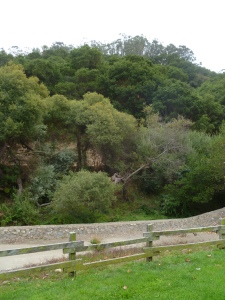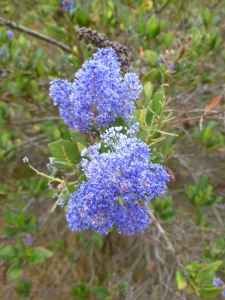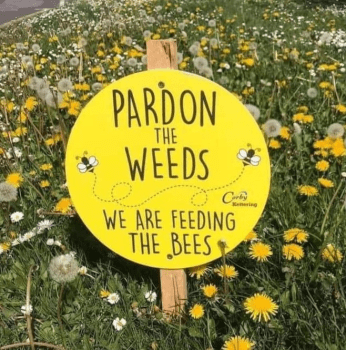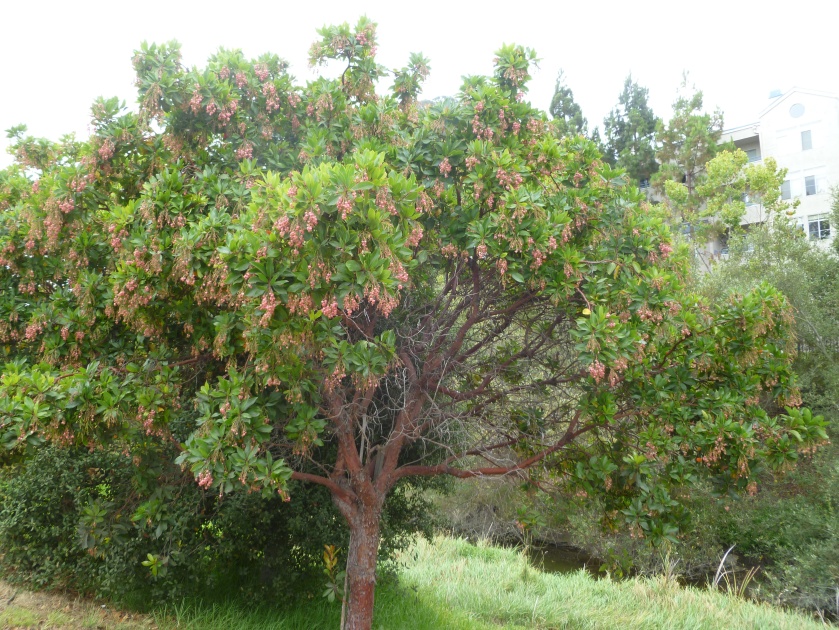In a recent edition of Jake Sigg’s Nature News, one of his readers compared the Sutro forest unfavorably to the eucalyptus forest on Albany Hill:
“The [Sutro] ‘ forest ‘ is unmanaged, many of the trees are deteriorated and unhealthy, spacing is unusual and given the super invasive ivies and H. blackberry, overall habitat diversity is degraded.
For example , I look at El Cerrito Hill [officially Albany Hill] (near Central Av exit of east bay I-80 at Golden Gate Fields) and see a ‘ eucalyptus’ forest with fewer and larger trees , featuring an adjacent and penetrating coast live oak woodland and a ground cover that features wide species diversity.
Granted El Cerrito does not have the fog intensity of Mt. Sutro, BUT it also shows signs of management…
Anyway, all of this is my un-scientific observation. I think, with some thinning of eucs, control of ivy and blackberry spread, the establishment of habitat corridors and discreet regions and maintenance of trails, that Mt. Sutro could continue to provide a ‘ forest’ aesthetic and include much improved habitat diversity and fire potential reduction.”
We are always trying to understand the perceptions of native plant advocates in the Bay Area, so we went to take a look at Albany Hill. We are happy to report that we found much to like. However, the comparison with the Sutro forest is mistaken in many ways, which we will explain in this post.
Creekside Park

We started our walk at the Creekside Park on the north side of Albany Hill. It is a riparian corridor created by the confluence of two creeks, Cerritos and Middle creeks. The vegetation is almost exclusively native. The Creekside Park is carefully tended by native plant advocates who have planted many of the natives, but the Coast Live Oaks that are the predominant tree species are said to have been here prior to settlement. (1)
The oaks cover the northern slope of Albany Hill, which was typical of native oak woodland in the East Bay . The oaks benefit from the water provided by the creek and they also occupied north-facing slopes where there is more moisture in the soil than on the south facing slopes that are exposed to the sun. The prevailing wind in the Bay Area is usually from the southwest, so there is also some protection from the wind on the north side of the hill. There were never any oaks on Mount Sutro, and the assumption that there will be in the future seems delusional, given their horticultural requirements.

Looking up from the Creekside Park, we can see the eucalyptus forest on the top of Albany Hill which has not “invaded” the oak woodland. The fact that the eucalyptus forest has not encroached on the oak woodland is documented by two planning documents. The first “Albany Hill Master Plan” was written in 1991. It included vegetation maps that can be compared to the second “Albany Hill Creekside Master Plan” which was written in 2011. The second plan states that the eucalyptus forest had not expanded during that 20 year period. It also states that the eucalyptus forest isn’t regenerating. That is, it is not replacing itself, let alone expanding. Yet, it is consistently called an “invasive species” in the master plan approved in 2012. (2) “Invasive” seems to be the pejorative adjective used by native plant advocates to describe all non-native plants and trees, whether actually invasive or not.
During that 20-year period from 1991 to 2011, the eucalyptus forest was not “managed” as Sigg’s correspondent believes, because the plan was not funded. (1) Hence, a second plan was written in 2011. This is a scenario we often see played out on our public lands. Elaborate plans are written. Often they are not implemented. Sometimes we are just as happy they aren’t.
Let’s enjoy a few of the beautiful native plants and trees before we leave Creekside Park to visit the eucalyptus forest on the top of the hill.
This is a lovely little Madrone in full bloom. We recall wanting to plant a Madrone in our backyard over 30 years ago. They weren’t available in nurseries then. We assume they are now, which is great. But we digress.
 This is one of the few California lilacs (ceanothus) we saw. Bumble bees were busy in the lilacs. They are nesting close by in the ground beneath an oak. If the bared ground on Mount Sutro is covered in the wood chips of the trees that are destroyed, as planned, native bees will not be able to penetrate that deep wood mulch.
This is one of the few California lilacs (ceanothus) we saw. Bumble bees were busy in the lilacs. They are nesting close by in the ground beneath an oak. If the bared ground on Mount Sutro is covered in the wood chips of the trees that are destroyed, as planned, native bees will not be able to penetrate that deep wood mulch.
 This is one of many lovely oak trees, surrounded by ivy, which doesn’t seem to be doing it any harm. In fact, the master plan for Albany Hill says there are no plans to eradicate ivy in the riparian corridor because it “…would require considerable cost and labor to fully eradicate and whose spread is often limited to areas in the immediate vicinity.”
This is one of many lovely oak trees, surrounded by ivy, which doesn’t seem to be doing it any harm. In fact, the master plan for Albany Hill says there are no plans to eradicate ivy in the riparian corridor because it “…would require considerable cost and labor to fully eradicate and whose spread is often limited to areas in the immediate vicinity.”
The Eucalyptus Forest on Albany Hill
The eucalyptus forest on Albany Hill was planted by a dynamite company in the late 19th century. The trees were planted to muffle the sound from frequent explosions, as well as provide some protection to neighboring residents. (1) There were many reasons why early settlers to the Bay Area planted eucalypts. Some were practical reasons, such as this, and some were aesthetic.
Albany Hill is much drier than Mount Sutro. It is further away from the ocean where fogs form and often hover for weeks on end during the summer. In general, the East Bay is considerably less foggy than San Francisco.
Because it is a much drier environment, the eucalyptus forest on Albany Hill is less dense than the Sutro forest and it has considerably less understory. The understory on Albany Hill is non-native annual grass and native toyon shrubs, which are said to have been planted either by man or by birds “carrying” seeds from other locations. (2) Hmmm….let’s stop to think about that. The toyon is a native shrub that was “introduced” to Albany Hill and is thriving there under the canopy of the eucalyptus forest. The 2012 master plan for Albany Hill says that the toyon understory has expanded since the 1991 master plan.
The future of the eucalyptus forest on Albany Hill
As we have said, the eucalyptus forest on Albany Hill has not been “managed” to date. Since the master plan was approved in 2012, only $50,000 has been allocated for vegetation management on Albany Hill. So, what is planned for the eucalyptus forest in the future? Here are the plans for the future, according to the master plan that was approved in 2012:
- The eucalyptus forest will be “phased out” slowly over time by removing hazardous trees as necessary to ensure public safety, removing new seedlings where the forest interfaces with native oak woodland, and not replacing trees that die of old age. Since the predominant species of eucalyptus in the Bay Area (Blue Gum) lives in Australia from 200-500 years, and it has been here for only about 100 years, it is reasonable to assume that this is a very long-term plan.
- This plan should require a lot less herbicide than destroying 90% of the trees on 75% of Mt. Sutro, as planned there, because we assume a dead tree will not resprout. A lot of herbicide is often needed to prevent resprouts after healthy eucalypts are cut down.
- The forest will be managed for fire safety by mowing the annual grasses, where ignition is most likely to occur; by limbing trees up to separate the understory shrubs from tree limbs to remove “fire ladders” to the tree canopy; and by cleaning woody debris from under the trees on an annual cycle.
- The plan acknowledges the benefit of maintaining a closed canopy, both in the eucalyptus forest and the oak woodland. The closed canopy shades the forest floor and suppresses the growth of non-native weeds.
This all sounds eminently reasonable to us: much less destructive than plans for the Sutro forest, yet addressing fire hazard and safety issues in a responsible way.
Neighbors on the leeward side of the hill will eventually lose their windbreak as the tall trees disappear, but that will happen so slowly that they are unlikely to react. On the other hand, plans for Albany Hill could change many times in the next 100 years. We hope the current preoccupation with the nativity of plants and trees will have faded long before the eucalyptus forest dies of old age.
And so, ironically, we agree with Jake Sigg’s correspondent that plans to manage Albany Hill are better than the plans to destroy the Sutro forest. We just don’t agree about why.
************************
(1) http://en.wikipedia.org/wiki/Albany_Hill
(2) “Albany Hill Creekside Master Plan,” City of Albany, 2012



Excellent article and beautiful pix. All of San Francisco (and the whole Bay Area) should be super-grateful that pro-environment people with common sense like you guys are continuing to fight for Sutro Forest, Mount Davidson, and our other endangered parks. I like this quote: “We hope the current preoccupation with the nativity of plants and trees will have faded long before the eucalyptus forest dies of old age.”
Interesting to read this post as we just returned home from from visiting our friends on Albany Hill, where typically we live for around a month or more of every year, just East of the forest.
Many years ago, when our families’ kids were toddlers, my friend noticed that the man doing some maintenance work on the hill was spraying Roundup. She expressed great concern and guess what? Unlike common responses when one talks to users of herbicides, this man listened to health concerns and promised not to use again. To our knowledge, whomever is doing maintenance has continued not to use chemicals. Last summer I talked with a newer young man whom I noticed doing work by hand.
If trees overhanging the actual trails are dying (not likely for 100-400 years), herbicides would never be needed anyway if a goal were to prevent resprouts; a standard practice is to use sheet plastic stapled down over a stump, or better yet one can use a dark natural fabric which then can decompose in place. One shuts down photosynthesis and voila! No resprouts. Simple, straightforward, effective.
Another brilliant post. Thank you!
The eucalyptus forest at Albany Hill should be preserved at all costs. Resprouts should be allowed to constantly regenerate the forest, within reason, considering fire hazard, overcrowding, and precipitation constraints particular to its east bay area location. Obviously, the forest needs to be kept healthy, so there are no Mt. Sutro problems. Neither killing trees or letting them just die off and not replace them is not a very good solution at all. It makes sense to keep the ivies and blackberry out if they affect the health of the eucalyptus forest. If they do not adversely affect the eucalyptus trees, then they should be allowed to grow, because a jungle looking eucalyptus forest is very impressive and green. The eucalyptus tree is so much a part of California now, that it would be reprehensible to allow it to slowly die off, regardless of what the California Invasive Plant Council says. People in the city need a forest refuge and the eucalyptus trees are already there in their majestic state – mature, green, and very tall, Aesthetics are extremely important for people in heavily congested urban areas. I think it is wise to keep the eucalyptus forest thriving, but separated from the oak forest. That way people can see two fine examples of California forests in one location. The reason the eucalyptus blue gum was brought over to California in the first place was for aesthetics. People love the majesty of these eucalyptus forests, and the climate is just right for them. Visitors, and residents, love the green California Coast. It leaves a lasting impression on many that the California Coast is one of the most beautiful places in the U.S., if not the world. The eucalyptus trees play a huge part in that. So why mess with them? There are plenty of other places where people can see native plants. Keep the eucalyptus forest, which is already there, thriving forever!!
DEATH BY EUCALYPTUS TREES BY RALPH T. FOSTER POSTED 3 MARCH 2019:
— MR. ARMINTOR HAVE YOU FOLLOWED THE DEATH TOLL IN JUST THE EAST BAY ALONE DUE TO FALLING EUCALYPTUS TREES SINCE YOUR LOVELY OCTOBER 2018 POSTING TO SAVE THE EUCALYPTUS TREES. A FEW DAYS AGO A TREE FELL ON THE VERY SPOT WHERE I HAVE OFTEN SEEN DOZENS OF CHILDREN PLAYING WHILE GOING TO AND FROM MY BUSINESS FOR THE PAST 45 YEARS: “A giant eucalyptus toppled some time Tuesday night crashing onto the playground at King Park on Hopkins Street in North Berkeley. Half a mile away, another tree fell during the storm, on Rose Street at MLK Jr. Way, crushing a truck and causing the roadway to be temporarily blocked. There were no reported injuries.” ONLY TIMING PREVENTED THE DEATH OF CHILDREN–MAYBE MANY CHILDREN. I HAVE LIVED ON ALBANY HILL FOR OVER 40 YEARS AND I FEAR IT IS ONLY A MATTER OF TIME BEFORE WE WILL HAVE CASUALTIES HERE. JUST GO TO 605 JACKSON AND TAKE A LOOK UP THE HILL AND I MEAN WAY UP. ON A CLIFF NEAR AND JUST ABOVE THE STREET–YOU’LL SEE HUGE EXPOSED ROOTS OF MANY MASSIVE SIZED TREES RIGHT ON THE EDGE OF THAT CLIFF. I ASK A RESIDENT AT THAT ADDRESS IF THEY ARE CONCERNED–HE LOOKED AT ME LIKE I WAS STRANGE AND LOOKED UP THE HILL AND THEN WENT INSIDE HIS UNIT. A FEW DAYS LATER I ASK AN ALBANY CITY PLANNER ABOUT THAT TREE AND 100S OF OTHER “WIDOW & WIDOWER-MAKERS” ON ALBANY HILL. SHE REPLIED THE CITY HAS APPLIED FOR A FEDERAL GRANT AND THAT BUTTERFLIES NEED THE TREES. I SAID “WHAT ABOUT PEOPLES LIVES AND RECENT DEATHS?” THESE TREES MAY SOON BE KILLING PEOPLE RIGHT HERE ON ALBANY HILL!” I BELIEVE SHE IS CONCERNED AS SHE WAS WALKING AROUND THE HILL CHECKING SOMETHING OUT. WE SMILED AWKWARDLY AND PARTED COMPANY.
I FEAR MANY ARE IGNORANT OR DO NOT CARE. THIS IS WRITTEN FOR THE RECORD. RALPH FOSTER
Yes, we have had some severe storms this winter and that’s when we see more tree failures than usual. However, eucalyptus trees are not more likely to fall than other tree species. I searched for “falling trees in San Francisco Bay Area” for a current random sample. Google found 15,900,000 articles fitting that description. Looking at the first 10 entries, most falling trees were not eucalyptus.
That sample is consistent with UC Berkeley’s “California Tree Failure Report Program”, which reports 6146 tree failures as of February 4, 2019 (https://ucanr.edu/sites/treefail/CTFRP_Statistics/):
Most commonly reported genera : Quercus (23.4%), Pinus (16.9%), Eucalyptus (12.5%) and Cupressus (including Hesperocyparis)(8.6%).
Next most commonly reported genera : Fraxinus (3.3%), Acacia (3.4%), Ulmus (3.2%), Liquidambar (2.6%), Pyrus (2.3%) Cedrus (2.1%), Sequoia (2.0%), Pseudotsuga (1.2%), Umbellularia (1.1%), Calocedrus (1.1%) and Prunus (1%). The remaining 85 reported genera are less than 1% each.
Origin of Reports (California counties): San Francisco (18.5%), Alameda (12.7%), San Mateo (12.3%), Santa Clara (10.1%), Contra Costa (4.7%), Los Angeles (4.4%), Napa (4.1%), Marin (3.4%), Shasta (2.6%) , Sonoma (2.6%), Santa Cruz (2.3%), San Joaquin (2.1%), Yolo (2.1%), Ventura (2.0%), Mariposa (1.7%), El Dorado (1.9), Solano (1.7%), Sacramento (1.6%), Trinity (1.3%), Monterey (1.2%) and Santa Barbara (1.0%). The remaining (less than 1% each) originated in 28 other California counties.
Written plans for Albany Hill say that the eucalyptus forest will be “phased out” slowly over time by removing hazardous trees as necessary to ensure public safety. That is a responsible plan because the trees are performing many valuable functions. They are habitat for wildlife. They are storing millions of tons of carbon that will be released into the atmosphere as greenhouse gases if the trees are destroyed. And they are a valuable windbreak for the surrounding community.
Thinning the forest will increase the likelihood of the remaining trees failing. Individual trees that suddenly become more exposed to high winds are more likely to fall. For this reason, any thinning of the forest that is considered must not be so extensive that it will subject remaining trees to increased windfall.
In the interests of public safety, you would be wise to consider the consequences of destroying the forest on Albany Hill. If you see specific trees that you consider hazardous, the City of Albany might be more responsive to your alarm. A qualified arborist could verify your judgment. I have no objection to destroying hazardous trees if the evaluation is made by a qualified professional with no ulterior motives and my article says as much.
Our personal experiences are a powerful influence on our opinions and I am no exception to that rule. My neighborhood park was almost entirely forested with eucalyptus, but when my friend was killed by a huge falling tree branch in 2008, it was a branch from a redwood tree that had been topped, creating dangerous conditions that were evaluated by an arborists 4 years before, but ignored. I am therefore committed to professional tree care and I am never opposed to destroying trees if needed. I have the native oak in my front yard professionally evaluated and pruned as needed every 3 years.
Another bit of advice about how to be more effective in your advocacy: writing in ALL CAPS is unnecessarily confrontational. Likewise, when communicating with the City of Albany, keep in mind that shouting is rarely effective because, ironically, people can’t hear you when you are yelling at them.
This is my public record. I care about my safety and my community’s.
Mr. Foster, as a mom I am deeply appreciative of your concern for children. We all can breathe a sigh of relief that none were harmed in the falls of those trees.
For over a decade, my family lived on Albany Hill housesitting and caring for our friends’ pets for about a month of every year, in a house up against the beautiful forest.
The water soaked up by the roots of the Eucs (like camels’ humps) kept the soil moist, therefore making us safer from possible fire than we’d be with just flammable oaks up there.
Yes, it’s true. Sometimes big branches or whole trees fall. Any tree may fall when under tremendous stress in a storm, but when there is a dense forest, roots intermingle and stabilize the soil. When U.C. bulldozed thousands of trees in the hills in the mid-2000’s, there were landslides as a result of soil destabilization.
Here’s what we do know: humans have contributed greatly to climate change, particularly in this society. The answer is not to rid ourselves of the very trees which can survive the climate changes in our region; these are our lungs, and our fire safety. Some of the old Eucs created fire breaks in the hills during the ’91 fire, while others caught fire not from the fire which was following gas lines and exploding houses, which then caught other houses on fire, and eventually some trees were killed, too.
David Ackerly, new Dean of the College of Natural Resources at U.C. Berkeley recently had to set the story straight when a few noisy people at a public lecture were yelling things like, “We need to get rid of all the “non-native” Eucalyptus trees. He said, “Homes are catching trees on fire and it goes homes to homes to homes. Trees have moisture.”
Just look at photos from the recent Camp Fire. You’ll see, as you see with fire photos all the time that, there were many trees which in fact did not catch on fire at all. We see stands of Eucalyptus acting not only as the wind breaks for which they were planted all over California around 150 years ago, but acting as fire breaks because of the stored water in their roots and trunks which keeps soil moist.
We need more trees, not less. With each tree needlessly taken down, carbon is released creating more climate change susceptibility, and interrupting the important oxygen/carbon dioxide exchange on which we depend, while also warming the soil. And where U.C. just decimated a lot of the forest at People’s Park, a little green space in an urban area with less trees than Manhattan (including a “native” plant forest which had been planted decades ago to demonstrate the variety of tree life around the state), now there is mud because the root system which helped direct water down toward the water table is gone. I returned from the park an hour ago. More carbon, less shade to aid in transpiration moving water to the ground, and now less ability for the soil to hold the water.
Downing healthy trees is dangerous.